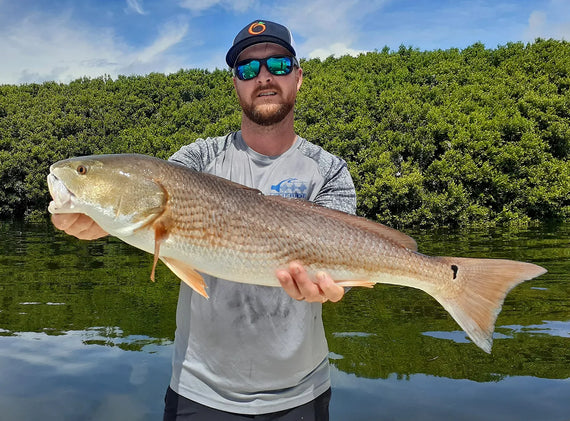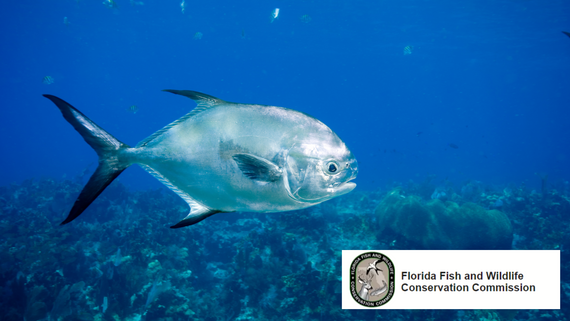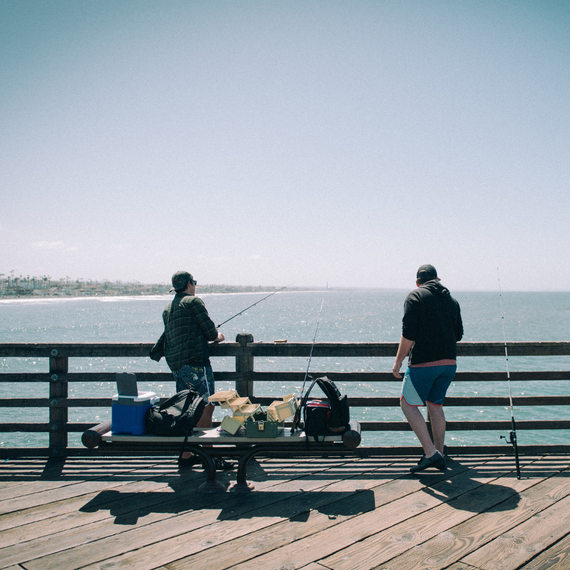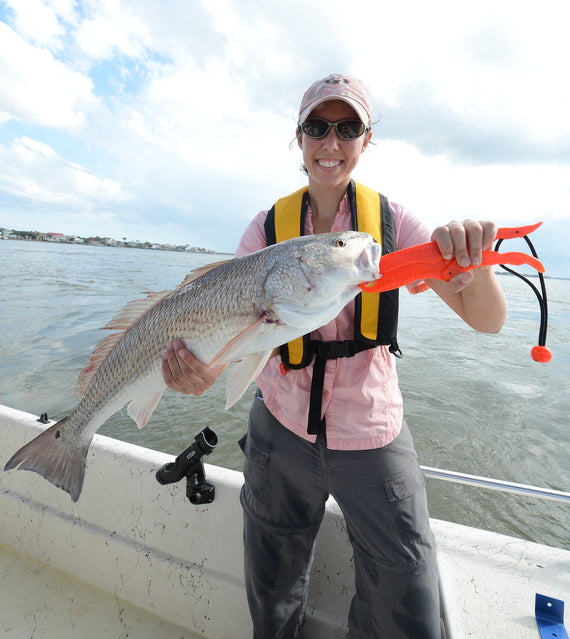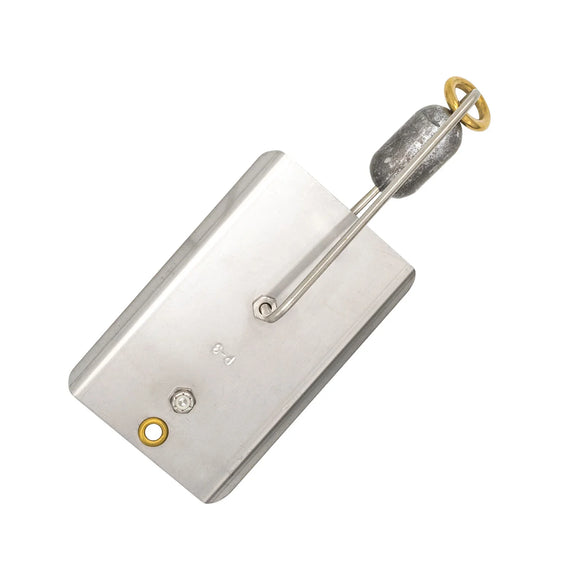-
![Fishing Pliers 101: A Must-Have Tool for Every Angler]()
Fishing Pliers 101: A Must-Have Tool for Every Angler
Ask any craftsman or builder, and they’ll each give you the same piece of advice: Use the right tool for the right job. For experienced anglers, that advice holds true. If you need a single tool to remove hooks from freshly caught fish or trim lines quickly, a single set of quality fish pliers is a lifesaver, and the best fishing pliers have multiple uses. What Are Fishing Pliers? Fishing pliers are specifically designed for the conditions experienced during fishing. In particular: They’re typically made of rust-resistant materials like stainless steel and aluminum. Their jaws are usually long and thin to reach into the throat of a fish and remove lures or hooks. Most have built-in cutters for slicing through lines. Their grips are rubberized or grooved, making them easy to hold onto in wet conditions. These are just some of the basic attributes you’ll find in nearly all fishing pliers; some sets are even more specialized for different tasks. Uses of Fishing Pliers Some fishing pliers feature small holes for pulling hooks to make tying knots easier; others have hooked noses to ensure proper grip on deep-seated hooks. Regardless of the particular differences among the many pliers available, their primary function remains the same: to remove hooks from the mouths of fish and cut fishing lines. Depending on the type of fishing pliers, they may also be used for crimping split shot sinkers and crimp sleeves. Still, since fish pliers are relatively simple tools, they’re also highly versatile for situations unrelated to fishing. They can retrieve dropped items from deep crevices, hold objects during repairs, or twist bent items back into shape. They especially come in handy when you want to pick up an object that might be harmful, such as a lump of hot coal from a campfire once you’re back on shore. Types of Fishing Pliers Which type of fish pliers do you need? Have a look at the following list and see if any appeal to you from the outset: Hook Removers: Can easily pull hooks from the mouths of fish with their bent or hooked jaw. Needle-nose Pliers: Feature long, narrow jaws and are excellent at a variety of jobs Crimping Pliers: Designed to crimp split shots and sleeves for heavy lines. Cutting Pliers: Often referred to as “wire cutters,” specialized cutters that do a better job at cutting fishing lines than a pair of needle-nose pliers. Split-Ring Pliers: Feature one pointed jaw that hooks over the second jaw; perfect for making secure attachment points for lures and hooks with split rings. Bent-Nose Pliers: Similar to needle-nose pliers, just with jaws bent to one side, can improve the viewing angle when removing hooks from fish. The types of pliers that best suit your needs may require some trial and error. You may find you prefer bent-nose to straight needle-nose or vice versa. At the same time, you may love having a dedicated set of cutting pliers or discover that the built-in cutting jaws on a standard set of pliers suit you just fine. Ultimately, the choice is yours. Choosing the Best Fishing Pliers Once you’ve decided on which type of pliers you need, it’s time to focus on the pliers’ other attributes, such as: Materials: The best fishing pliers are made of corrosion-resistant substances that can withstand years of heavy use, such as stainless steel and aluminum Durability: Even if the pliers are essentially rustproof, they may be poorly designed and fall apart after minimal use Comfort: If the pliers don’t have rubber grips, they should be shaped to avoid sharp edges or hard points and maximize comfort. While comfort is always essential, strong materials and good design are especially important for severe environments such as saltwater, which leads us to our next point. Best Saltwater Fishing Pliers The presence of salt risks destroying your boat, gear, and tools. Not only that, but the fish and animals you encounter will be much larger, meaning all your equipment will have to be scaled up accordingly. If you’re using a thick line that requires crimping, for instance, you’re going to have to have cutters that are up to the task. A heavy-duty set of multi-tool saltwater fishing pliers that gives the user plenty of leverage to crimp even the heaviest crimp sleeves would be a welcome companion. Such a tool allows an angler to have a single device to handle multiple operations without carrying extra pliers. Should you need a set of fishing pliers to remove a hook from deep in your catch's gullet, you may want a similarly strong and sturdy premium set with needle-nose jaws, two different crimping slots, built-in vise grips, and perhaps even a bottle opener. Maintaining Your Fishing Pliers Even the hardiest, strongest pliers still need care. Here’s how to keep yours going strong: Rinse off your pliers after use with freshwater, never saltwater Dry your pliers thoroughly with a cloth or towel Periodically lubricate your pliers with WD-40 or an equivalent, then wipe clean When you’re not using your pliers, store them in a dry location Continually inspect your pliers for signs of rust or damage, and always test them before use Lastly, you’ll want to purchase your pliers from a reputable company. Not only are you far more likely to get a solid product in the first place, but you can also rest assured knowing that an honest manufacturer will back your pliers. If you ever have problems with your pliers, you should be able to contact the company and get professional repair, cleaning, or replacement. Frequently Asked Questions About Fishing Pliers Can You Carry-On Fishing Pliers? As long as the pliers don’t have a blade and are less than seven inches long from end to end, you can carry them onto a plane. Otherwise, they’ll have to go in your checked baggage. What Are the Holes for on Fishing Pliers? Some fishing pliers have holes for pulling hooks, which makes tying knots easier. The holes may also aid in bending wires or crimping.Read more -
![The Largest Fish Ever Caught on Rod and Reel]()
The Largest Fish Ever Caught on Rod and Reel
Regular-sized fish may be the norm, but there are also people who have caught large, record-breaking creatures with just their trusty rod and reel. Here are some of the largest fish ever caught over the years.Read more -
![6 Best Rigs and Baits For Catching Redfish]()
6 Best Rigs and Baits For Catching Redfish
Redfish are one of the most popular sport fish in the United States. Some might even describe them as one of the most accommodating inshore gamefish. An enthusiast can catch red drums in almost any imaginable way! Why are redfish so popular with fishermen? The reasons are simple: they strike hard when hooked, can get very big, and remain delectable when adequately prepared. Moreover, red drums don’t generally take long runs like numerous other game fish, they’re unfussy eaters but put up a great fight. Finding the perfect redfish rig, bait, or lure can be challenging, as there’s no one-size-fits-all solution. With various options out there to choose from that can fill a cooler in no time, our team from Rite Angler wants to break down some of the best redfish rigs, lures, and baits. Top Jig Rigs for Redfish The best redfish lures, baits, and rigs will depend on where and how you want to fish and the size of the redfish you’re fishing for. The best redfish rigs for pier or beach fishing may not ideally suit fishing for red drums in grass flats or other areas. That said, here are our best rigs for redfish. Most fishermen only need 2 to 3 redfish rigs for their purposes. Once you succeed with a few setups, trying out different options might help you achieve better results. Jig Rigs Jig rigs serve as one of the simplest redfish rigs for pier fishing, are incredibly versatile, and remain suitable for numerous kinds of baits and fishing techniques. However, fishermen must remember that jig heads, or any hooks for that matter, can easily become snagged in cover. Jig rigs are suitable in almost any situation where we can find redfish close to shore, making them the ideal redfish rigs for pier fishing, jetties, surf casting, or when fishing from a boat. The easiest way to set up a jig rig is by tying a jig head directly to the main line. Some fishermen may also choose to use a few feet of fluorocarbon leader as a helpful addition in clear-water conditions. Simply bait a jig head with your bait of choice and cast it out, letting it sink to the bottom. When retrieving the lure, bounce the jig rig along the bottom. This technique will help the rig perform better and attract redfish who feed on the bottom. Let’s take a look at the best jig rigs that you can use on your next fishing adventure. Soft Plastic Jigs The most common soft plastic jigs have a small “tail” that emits a scent to attract redfish. While fish like snook feed utilizing their sight, redfish typically feed by smell. You can determine the speed and action of the soft plastic jigs after determining where redfish reside in the water column. To enhance your soft plastic rig setup for redfish, consider experimenting with different jig styles and sizes. Paddle tails, for example, create more vibration in the water, mimicking the movement of baitfish, which can be particularly effective when redfish feed aggressively. Additionally, pairing your soft plastics with a weighted jighead allows you to control the lure's depth and presentation, making it easier to target fish at different levels in the water column. Remember to adjust your retrieve speed depending on the behavior of the redfish and the water conditions, ensuring your lure looks as natural as possible. Topwater Skimmer Jigs When fishing in shallower waters, flats, or clear water, topwater skimmer jigs can entice red drums to produce one of the most exciting topwater strikes a fisherman will ever experience. You can position a topwater skimmer jig anywhere in the water column, and they work well even near the bottom. With a medium sink rate, many topwater jigs provide the necessary time to present the bait properly. Topwater skimmer jigs are especially effective in the early morning or late evening when redfish are more likely to feed near the surface. Their lifelike action and splash create a disturbance that mimics a fleeing baitfish, triggering aggressive strikes from redfish patrolling shallow waters. Popping Cork Rig The popping cork is a favorite for many fishermen aiming for inshore redfish. The setup works best in cold, shallow water under 5 feet in depth. Low water temperatures make the red drums more lethargic. Popping cork redfish rigs make a chugging sound with a popping cork that stimulates and attracts redfish to the surface commotion. The “pop-pop-pop” sound simulates surface feeding or bait fleeing from predators. Game fish come to investigate the sounds or catch a scent of dangling bait enabling the fishermen to set the hook. Best Baits for Redfish Getting the redfish to bite is as much about the bait as the rig and lure. You must consider everything about the water where you fish and best redfish bait to make the ideal choice. Shrimp Live shrimp is one of the most widely available bait options for catching redfish. More importantly, redfish love the smell and taste of baited shrimp, rarely ignoring them. The secret to fishing with live shrimp is to try and keep the shrimp alive and healthy for as long as possible. A lively shrimp will keep moving in the water, helping a redfish to spot it easily. Crab Live crab is among the best baits available today for catching larger bull redfish. Larger reds will have a larger mouth, enabling them to devour an entire crab with little problem. The best way to rig a live crab is to remove a leg and place the hook through a leg hole. You should guide the hook through the crab shell, firmly setting it in place. Moreover, when fishing for smaller red drums. Top Redfish Lures When selecting the best redfish lures, a few consistently stand out due to their effectiveness. These lures are designed to mimic the natural prey of redfish, making them irresistible to these aggressive feeders and the best lures for redfish. Here are a few popular lures that can help you attract and catch redfish: Shrimp Imitations Shrimp lures are incredibly effective, especially when fishing in areas where shrimp are a natural food source. Their realistic movement and scent can easily entice a strike from a redfish. Shrimp lures can be fished under a popping cork or on a jighead, making them versatile for different water depths and conditions. Whether you're fishing in shallow flats or deeper channels, shrimp imitations closely resemble the natural diet of redfish, increasing your chances of a successful catch. Soft Plastic Jerkbaits Jerkbaits offer a lifelike presentation that can trigger redfish to strike, particularly in clear water or when redfish are feeding on small baitfish. These lures can be worked with a twitch-and-pause retrieve, mimicking the erratic movement of injured bait, which often provokes aggressive strikes from redfish. Soft plastic jerk baits are also highly versatile and can be rigged weedless, making them ideal for fishing in grassy flats or around structures without getting snagged. Weedless Spoons Many fishermen choose the classic tried-and-true spoon. It is the closest option to a utilitarian approach to catching numerous different types of saltwater fish. Today’s tackle market provides fishermen with an array of spoons. Nonetheless, seeking a weedless option when fishing grass flats is critical to prevent the lure from getting stuck in the brush. Spoons are an excellent search bait for finding redfish as they cover a ton of water, enabling fishermen to figure out precisely where they can find the feeding red drums. Selecting the best lure for redfish ensures you're equipped to handle these powerful fish, increasing your chances of a successful catch no matter where you cast your line. Whether you're fishing in shallow flats or deeper waters, using good lures for redfish can make all the difference in your success. The Right Tools to Fill Your Cooler Hopefully, with the right redfish rigs, baits, and lures at your disposal, you’ve discovered some new ways to help you reel in more redfish. Many of these setups are ideal redfish rigs for pier fishing, shallow water fishing, and fishing from a boat. These rigs also work well for other inshore saltwater fishing applications like trout, snook, and flounder. Rite Angler provides high-quality fishing tackle and other equipment for serious fishermen. Founded in 1990, we design our products for fishing men and women who understand the importance of quality equipment. Rite Angler's product design uses only the best anti-corrosive materials. We focus on producing superior tackle options for all your fishing equipment needs. You can rely on Rite Angler for the proper lures, lines, and tackle to stand up against the elements (and the fish)! FAQs What is the best bait to catch redfish on?Live shrimp and live crabs are some of the best bait options for catching redfish because of their strong scent and natural movement, which easily attract redfish. Redfish are bottom feeders and rely heavily on their sense of smell, making these baits especially effective. Other excellent bait choices include pogies, mullets, pilchards, and greenies, all of which mimic the natural prey that redfish often feed on in their habitat. What is the best line setup for redfish?A fluorocarbon leader paired with a braided mainline is the best line setup for redfish. The braided line offers strength and durability, making it easier to handle larger fish, while the fluorocarbon leader remains nearly invisible underwater, increasing your chances of fooling the redfish. This combination gives you the right balance of stealth and strength for successful redfish fishing. What is the best bobber for redfish?The best bobber for targeting redfish is the popping cork. Popping corks work by creating a splashing and chugging noise on the water's surface, which mimics the sounds of prey being attacked. This noise triggers a predatory response from nearby redfish, drawing them toward your bait. It’s especially effective in shallow water where redfish hunt near the surface or in grassy flats. What is the best size hook for redfish?The ideal hook size for redfish generally falls between 1/0 and 3/0, depending on the size of the bait and the fish you're targeting. A 1/0 hook works well for smaller live bait like shrimp, while larger hooks like 2/0 or 3/0 are better suited for larger baits like crabs or cut bait when targeting larger bull redfish. The hook size should be chosen based on both the bait size and the fish size to ensure a secure catch.Read more -
![Why Do I Need a Fishing license?]()
Why Do I Need a Fishing license?
Going out fishing is an amazing way to spend a peaceful day alone or an engaging day with your family or friends. But no matter if you’re catch and release fishing, or looking to fill the cooler with “meat,” chances are you’ll need a fishing license to fully enjoy your time.Read more -
![Reel in the Fun: Offshore Fishing Adventures in the Summer!]()
Reel in the Fun: Offshore Fishing Adventures in the Summer!
When the summer sun is shining brightly, there's no better way to beat the heat than heading offshore for an exhilarating fishing expedition. Offshore fishing offers anglers a chance to explore the vast open waters, test their skills, and reel in some incredible catches. So, grab your fishing gear, hop in your boat, and get ready to embark on an unforgettable summer adventure! 1. Choosing the Perfect Destination: The first step in planning your offshore fishing trip is selecting the perfect destination. Whether you're an experienced angler or a beginner, there are plenty of options to suit your preferences. Popular summer fishing spots include the Gulf of Mexico, the Caribbean, the Atlantic Ocean, and the Pacific coastlines. Research the target species, weather patterns, and local regulations to find the ideal location for your fishing expedition. Decide how far you are willing to go offshore and your comfort zone. Watch the weather and make sure you have all the gear in case of summer time storms. 2. Target Species: One of the most exciting aspects of offshore fishing is the opportunity to catch a wide variety of species. From massive game fish like marlin and tuna to delicious table fare like mahi-mahi and snapper, the offshore waters are teeming with possibilities. Research the seasonal patterns and migrations of your target species to increase your chances of a successful catch. 3. Choosing the right gear: This is one of the most critical parts of your offshore adventure! Once you have the previous two bullet points determined you can start getting the gear ready. Whether you are running 60 miles offshore to the gulf stream or just offshore to your local reef, having the right gear is the most critical part to your offshore summertime fishing success. Remember to always have backup gear in case your targeted species is hard to catch that day.Read more -
![Barrel Swivels | Uses and Tips]()
Barrel Swivels
Unless you’re a seasoned angler, you are not alone if you are wondering how to use a barrel swivel. Thousands of anglers struggle with how to use a barrel swivel. What even is a barrel swivel? When should you use it? The importance of a barrel swivel cannot be understated. The experts at Rite Angler have compiled a helpful guide to assist new and less experienced anglers using a barrel swivel for saltwater fishing! What is a Barrel Swivel? A barrel swivel is a unique piece of tackle that allows anglers to be more efficient in the water. Barrel swivels allow the fishing line to untwist during retrieval and help prevent tangling. The barrel swivel lets the two lines rotate independently, allowing the line to untie itself during casting and retrieval. It can also apply weight, helping the line sink further into the ocean and find new schools of fish to catch. For inexperienced anglers, a barrel swivel can help ensure your first cast or drop is not one of frustration as your lines tangle and twist with the shifting of the water. Because of current and tide and drifting, saltwater is notorious for tying up lines with one another, leading to line loss and immense frustration. Why is a Barrel Swivel Important? Lines that are twisted weaken one another, leading to untimely snaps and a loss of both rig, bait, and catch! A barrel swivel keeps the lines untangled. Naturally, this ensures that the line will remain strong and not snap during casting or retrieval, or a drop down to the reef–especially if it is wrestling with a strong fish. You can see how frustrating that would be, especially since repairing a line and attaching new bait takes time–time that could be spent catching another fish or chatting with a new friend at the pier. When Should You Use a Barrel Swivel? Fishing in the ocean usually leads to your line getting tangled in the water's shifting currents. While it's not required, it should be mandatory in tumultuous waters. A barrel swivel ensures your lines remain untangled and strong, saving you headaches and trouble later in your fishing adventure. For new anglers, a barrel swivel can save time as you are still learning the sport. It familiarizes you with tackle and other tack pieces' functions during a cast or drop. Plus, the weight of a barrel swivel can help sink your line further in the ocean, enticing more fish to swim up and take a bite. Where Can You Find a Barrel Swivel? Rite Angler has premier, high-quality barrel swivels and saltwater fishing gear for the serious angler. We also supply other terminal tackle, rigs, tools, cutlery and lures for new and experienced anglers. Our barrel swivels are made by anglers for anglers, with a satisfaction guarantee on every piece of terminal tackle. Our barrel swivel is made with highly corrosion-resistant materials and is graded for saltwater use while maintaining the strength to wrestle and pull large fish to the surface.Read more -
![3 Pier Fishing Tips and Tricks | Rite Angler]()
3 Pier Fishing Tips and Tricks
If you want a fun, adventurous, and relaxing weekend adventure, pier fishing is your excursion! What screams relaxation more than sitting, casting your line, and enjoying the beautiful weather as you snag a few story-worthy fish?Read more -
![How to Catch Redfish From a Pier | Tips and Tricks]()
How to Catch Redfish From a Pier
Do you want to know some of the best tips and tricks on how to catch redfish from a pier? There is no other fish like the redfish, and when you land a good one, you’ll be thrilled beyond words. The smell of the sea and the satisfaction of reeling in a big catch is unlike anything else in the world.Read more -
![Downrigger vs. Planer: The Most Cost-Effective Way to Troll Down Deep]()
Downrigger vs. Planer: The Most Cost-Effective Way to Troll Down Deep
Downrigger vs. planer: which one should you use? Well, it depends on a few things. It seems like every fishing forum has had a debate of downrigger vs. planer, with both having their pros and cons. But which one is the better option for your next trolling adventure… And which one is the most cost effective? What is a Downrigger? Using a heavy metal weight and specialized “rod” system, a downrigger setup is used in trolling to place bait at a desired depth. This allows for more precise fishing and effective targeting of suspended fish schools, or fish that hunt below the surface. A downrigger can be especially effective when using your sounder to find fish, then deploying your baits to the exact depth. Downriggers for fishing allow a good mix of depth control and stability, although they can be very expensive and cumbersome. Characteristics A downrigger setup is larger than a planer and requires skill but can be deployed deeper than a planer. A downrigger rig has a metal cannonball that generally weighs between five and 25 pounds. It has a spool, weight, boom, rod holder and cable to control everything. An entire downrigger setup can cost upwards of $300 and comes with either manual and electric spools for weight deployment and retrieval. Downriggers allow for high-speed trolling with less tension on the rod. Pros Downriggers can go deeper, 200 feet or more Downriggers put less pressure on the rod Provides more reliable depth control than a planer One of the most popular methods for HST Suitable for deep reef trolling for Grouper Cons Far more expensive than a fishing planer Does not use the force of the water for depth control They are complex to use and set up It is often stationary and cumbersome Does not fit in a tackle box What is a Planer? A fishing planer is a specialized metal fishing tool that helps anglers target and catch fish that hunt below the surface. In the debate of downrigger vs. planer, planers are often cited as the more affordable option for anglers and work excellently during times when the fish swim a little higher in the water column, anywhere between 5 and 30 feet down. Characteristics Planers are smaller and lighter than a downriggers and act as a hydrofoil when deployed. They have a sliding metal ring that release tension on the line when a fish strikes. Planers are often used by connecting direct to the mainline or attached to a cleat on the transom with the mainline attached to the planer by rubber bands. Planers also do not have a heavy lead sinker like a downrigger. Instead, the forward motion of the boat causes the hydrofoil shape of the planer to “push” down deep. Pros Very affordable It works better when fish like wahoo swim a bit higher in the water column They are easy to use No special equipment needed. It uses water to force depth Different planer sizes mean different depths Fits in a tacklebox Can be run directly on your mainline Cons Planer rods must be well separated to avoid tangles Generally only reaches about thirty feet in depth depending on planer size Ineffective during months when the fish are down very deep Tough to manage in rough seas Can be difficult to retrieve while boat is in motion So, Downrigger Vs. Planer: Which One? A downrigger for fishing and an ordinary fishing planer are effective for deep-sea trolling for different purposes. Both are effective getting your baits deeper to catch certain species of fish. A good rule of thumb is to consider where you will be fishing and how. A downrigger will be your best option if cost is no issue, and you want to get your baits very deep. If you’re looking for a cheaper alternative to getting your baits down, then a fishing planer is the better option. As far as cost effectiveness goes, it’s hard to beat a planer! You can find high quality fishing planers at Rite Angler. They’re great for targeting wahoo, kingfish, tuna and more!Read more

















